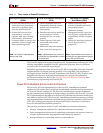
18 www.xilinx.com PowerPC™ 405 Processor Block Reference Guide
1-800-255-7778 UG018 (v2.0) August 20, 2004
Chapter 1: Introduction to the PowerPC 405 Processor
R
The PowerPC architecture requires that all PowerPC implementations adhere to the UISA,
offering compatibility among all PowerPC application programs. However, different
versions of the VEA and OEA are permitted.
Embedded applications written for the PowerPC 405 are compatible with other PowerPC
implementations. Privileged software generally is not compatible. The migration of
privileged software from the PowerPC architecture to the PowerPC 405 is in many cases
straightforward because of the simplifications made by the PowerPC embedded-
environment architecture. Refer to the PowerPC Processor Reference Guide for more
information on programming the PowerPC 405.
PowerPC Embedded-Environment Architecture
The PowerPC 405 is an implementation of the PowerPC embedded-environment
architecture. This architecture is optimized for embedded controllers and is a forerunner to
the PowerPC Book-E architecture. The PowerPC embedded-environment architecture
provides an alternative definition for certain features specified by the PowerPC VEA and
OEA. Implementations that adhere to the PowerPC embedded-environment architecture
also adhere to the PowerPC UISA. PowerPC embedded-environment processors are 32-bit
only implementations and thus do not include the special 64-bit extensions to the PowerPC
UISA. Also, floating-point support can be provided either in hardware or software by
PowerPC embedded-environment processors.
The following are features of the PowerPC embedded-environment architecture:
x Memory management optimized for embedded software environments.
x Cache-management instructions for optimizing performance and memory control in
complex applications that are graphically and numerically intensive.
x Storage attributes for controlling memory-system behavior.
Table 1-1: Three Levels of PowerPC Architecture
User Instruction-Set Architecture
(UISA)
Virtual Environment Architecture
(VEA)
Operating Environment
Architecture (OEA)
x
Defines the architecture level to
which user-level (sometimes
referred to as problem state)
software should conform
x Defines the base user-level
instruction set, user-level
registers, data types, floating-
point memory conventions,
exception model as seen by user
programs, memory model, and
the programming model
x Defines additional user-level
functionality that falls outside
typical user-level software
requirements
x Describes the memory model for
an environment in which
multiple devices can access
memory
x Defines aspects of the cache
model and cache-control
instructions
x Defines the time-base resources
from a user-level perspective
x
x
Defines supervisor-level
resources typically required by
an operating system
x Defines the memory-
management model, supervisor-
level registers, synchronization
requirements, and the exception
model
x Defines the time-base resources
from a supervisor-level
perspective
Note: All PowerPC implementations
adhere to the UISA.
Note: Implementations that conform to
the VEA level are guaranteed to conform
to the UISA level.
Note: Implementations that conform to
the OEA level are guaranteed to conform
to the UISA and VEA levels.


















